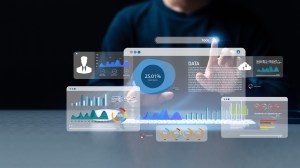How can data help transform the UK healthcare system?



How can data mitigate the worst impacts of the current crisis in the NHS and across healthcare provision generally? Find out here.

Nick Barnes
Even if you don’t work in the healthcare sector, it’s been impossible to ignore the ongoing headlines about the challenges facing the NHS and other healthcare providers. As the health sector recovers from the impact of the pandemic, we are seeing record waiting times and people missing vital health screenings; the backlog is even pushing some practices to breaking point.
At our recent Salesforce World Tour Live event, we gathered a panel of experts, including Kevin Riley, CCO Life Sciences at Salesforce as well as Simon Eccles, former chief clinical information officer at NHS England and Harsh Ghandi, Head of platforms for MarTech and Patient Engagement at AstraZeneca. We posed the question, “How can data mitigate the worst impacts of the current crisis in the NHS and across healthcare provision generally?”
The impact CRM could have on patients
The healthcare industry has made giant leaps during the pandemic, “seeing ten years’ worth of innovation in two years,” according to Kevin Riley in his opening statement. However, healthcare providers need to get back to pre-pandemic levels of activity, as those with life-threatening diseases are at risk of not being diagnosed in time. Diving in with what CRM means to healthcare, could incorporating digital channels that play a greater role in a patient’s engagement with the healthcare system be the cure that the NHS and other providers need?
A striking statistic mentioned during the session is that just under one million women missed their mammograms, 8,600 of whom may have been living with undetected breast cancer. Keeping a register of women able to come in at short notice to take up any unused slots was one suggestion for how CRM could help address the backlog.
A recent poll of GPs found that 91% of respondents noted an increase in administrative overheads – something that limits the amount of time they can spend with patients. Data can often be fragmented when it’s not unified through a singular system. Common issues that currently crop up include; patients being asked for the same information at different points in a medical process; or a letter about an appointment being rescheduled that arrives weeks after the appointment was supposed to have happened.
With unified access to patient information, the NHS and other healthcare providers could streamline the experience for both GPs and patients. Take the situation of the late letters – a unified patient view also opens up the opportunity to communicate in a way that better meets the patient’s personal preference.
For the independent sector providing capacity to the NHS would be a major boost. NHS spending on private healthcare is up 27% in a year, to more than £18Bn in 2020-21, but potential capacity in key specialities is going unused. The difficulty comes from challenges with eRS system referrals and the funding model making referrals to the private sector inefficient or not incentivised. A key benefit of the partnership is that there’s no cost to patients using a private provider through an NHS internal referral, and it costs the NHS no more than if an NHS provider delivered the activity).
Now is the time to ask the question – how can better use of data help the referral management process to drive greater efficiency, lower waiting lists, and deliver a cohesive patient experience? The private sector wants to help, and we should promote a holistic view of all organisations in healthcare partnering with the NHS is key to improving patient flow across health and social care.
Connecting with Patients for More Customised Care
Gain greater insight into patient needs and enable more personalised care and communications.



How understanding patient preferences and habits could reduce backlogs
When looking at how digital channels can bring greater connectivity and personalisation, the user experience needs to be more tailored to the modern world. Simon agrees, believing that more should be “taken into account, not just health conditions but contact preferences, transport needs and an understanding of your network of carers.”
But how can we make it easy for CIOs to do the right thing for their patients? Simon believes “we should know those people we only need to contact once for them to turn up, versus which people need a choice of times. For people that don’t respond to letters, sending them more letters is probably not the most effective method, but we do that millions of times a week resulting in a lot of wasted slots.”
Fundamentally, healthcare providers would benefit from a system that could understand how best to communicate with people, highlighting at-risk patients and those who need to be communicated with in specialised ways – and allowing them to reach those who may fall through the cracks in the system.
Patients can also benefit from more personalised engagement as it can activate them in managing their health and wellness, educating them on what proactive measures they can take to better manage their condition.
The role of CRM in improving patient outcomes
Healthcare companies could also utilise the data of the NHS in different ways. Harsh reiterated data’s importance: “Data is currently very fragmented; if we could find a way to unify it and find cohesion, that would be the holy grail.” It’s been said that the cure for cancer is in the data we have already; we just have to find the connecting data points to unlock it.
Simon underlined the point by stating, “The NHS has rich data stores. How do we take that personal data, anonymise it, and use it for the greater good?” He also added that the Healthcare providers should “stop thinking in terms just of the therapeutic agency and more about the service, offering personalised advice and guidance to address the major health issues affecting the country.”
With this, the challenge becomes getting data to clinicians. CRM can be the key, linking different parts of the journey together to find connections. But this also requires access to the data in the first instance to sort through, which can be very challenging to gain. Employing CRM analytics and powerful AI tools will make a fundamental change in helping to make sense of large volumes of data.
The importance of consent
To be able to utilise data beneficially, consent will be critical. The panellists had their thoughts on how they would tackle this. Simon believes “a good CRM is part of the answer to the problem. In the One London initiative, only 2% of people objected to the use of their data – this rose to 20% when people didn’t know what it was being used for.” Providing patients with greater transparency over the three key parts of consent: what is held, why it is held (for what purpose/use), and where it is held, is highly persuasive in building their confidence to grant consent.
That means the controls will need to be intuitive – within the modern world, we’re used to giving our consent. Simon revealed that “50% of people are using the NHS app”. Alongside making the controls straightforward, the main reason is to communicate the perceived value they will receive from sharing their data. Once that has been understood, they will be much more willing to do so.
Harsh believes that “we must stay in tandem with changing legislation. We know that data is powerful and want as much as possible. We scare people off from gathering data – let’s not make consent prohibitive.” Proper data controls through a unified platform can ensure patients’ consent before data is utilised for a distinct purpose that can deliver value to individual and population health.
Key takeaways
Personalisation in healthcare is highly desirable for today’s healthcare patients. Over in the US, 75% of consumers wish their healthcare experiences were more personalised, proving that healthcare providers globally have to understand the human element of how people want to be communicated with and any special needs they may have.
However, this inevitably raises issues of consent and patients are entitled to know how their data is being used by whom and for how long. Our Customer Data Platform is now integrated with the Health Cloud, which points towards a future where clinical and behavioural data can be brought together to achieve greater transparency and better health outcomes.
Patient activation as a strategy should also be considered, encouraging patients to participate in their care and well-being. This would also alleviate some of the pressure off healthcare providers by allowing patients to be actively engaged in managing their health conditions.
Ultimately, the panellists confirmed my belief that, while the challenges facing the NHS are severe, innovation – whether through CRM or other technologies – has an important role to play in promoting the efficiencies that will allow our public health system to deliver the services we all need. And, further, that data also holds the promise of cures and pre-emptive strategies that will reduce the need for such services in the first place.
Connecting with Patients for More Customised Care
Gain greater insight into patient needs and enable more personalised care and communications.






















